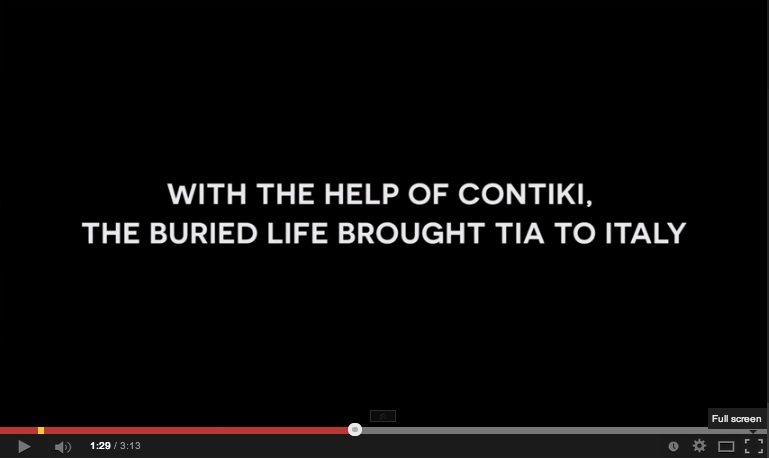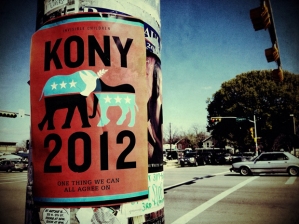Tagged: youtube
Lessons in Life and Marketing Partnerships from Contiki and The Buried Life
This morning I came across across a sweet video that brought tears to my eyes. It was the story of two young adults (Tia from Wisconsin and Justin who is in the Air Force, stationed in Italy) who met as kids and have stayed in touch over 9 years using social media. The Buried Life, with support from Contiki Tours, took Tia to Italy and filmed the reunion.
I’ve been happily following The Buried Life since their TV show got cancelled. Since then, they’ve continued inspiring people: they wrote a book, have conducted speaking tours, have gotten involved in charities and even organized the donation of a custom bionic arm for a 19-year-old girl.
While I have never been on a Contiki tour, I think it is a great brand and have written a post about one of their previous campaigns.
The Buried Life and Contiki are two brands that seem made for a partnership. The former is spreads a message about living life to the fullest and the latter sells unique life experiences. This partnership stands out because Contiki and The Buried Life came together and told a story. Also, the branding doesn’t slap you across the face. The only presence of Contiki or The Buried Life brands is the following text mid-video:
This social video is part of an ongoing relationship between the two brands. In May, the partnership was announced and the public was invited to apply to be The Buried Life’s #5thmember. Besides Tia’s trip above, Contiki has sponsored The Buried Life to take another girl to Italy as the #5thmember and documented her very first travel experience. The campaign is a great way for Contiki to promote their product (travel) and for The Buried Life to continue creating motivational content. In addition to providing great content for their fans, both brands are able to tap into each other’s audience. Contiki is a top travel tour company for millenials and The Buried Life has a strong following on social media (their Facebook page has over 1.3 million fans). As part of the campaign, Contiki is offering $100 off any Contiki deal using a special promo code. The discount is the perfect campaign extension to convert engaged viewers into paying customers.
The video reminded me how great it can be when two brands come together to take their marketing to the next level. Here are some tips you should consider when creating a marketing partnership:
- Choose a partner that is a good fit for your brand.
- Come up with an idea that is creative, unique and will be engaging to followers of both brands.
- Be strategic – reach out to your potential customers where you know they are looking for interesting content.
- Don’t let the branding/sell overshadow the content. It is important to be authentic.
- While social media is a great distribution tool, it is not the only option. For example, a live event might be the right approach for you and your partner. Again, get creative.
What are your tips for creating an effective partnership? Let me know in the comments below.
Kony 2012
I don’t think any marketing campaign has shown the power of social media than the Kony 2012 film posted to Youtube by the charity Invisible Children. According to Businessweek, the video had over 112 million views in its first week and in a poll done by Pew Research Centre showed that a quarter of Americans 18 to 29 had watched it. After reading the article, I watched the film and was completely moved.
Not only did the film go viral, but embedded within the film is the story about how social media helped build Invisible Children into the thriving charity it has become. It is a demonstration of documentary filmmaking that could rival anything done by Michael Moore and goes one step further with a strong call to action for viewers. The result: nearly 2 million visitors to the donation page within the first few weeks (and tons of media attention).
The purpose of the film was to bring attention to Joseph Kony, a man from Uganda, who has for decades led the L.R.A. army by stealing children in the night.
The ultimate goal is to see Kony captured. But the people at Invisible Children understand that in order for International governments of the world to send resources to Africa to help find Kony, the public needs to demand it. The call to action is for viewers to help create awareness by sharing the video and placing marketing materials all over public spaces. The video itself is a marketing tool, but it also encourages each viewer to become a part of the marketing effort. It shows an understanding that increasingly, marketers must engage the public into participating in order for a campaign to stand out. Social networking means people seek out information from the people they know and trust. In understanding this, Invisible Children has captured the interest of the millennial generation better than any other traditional charity.
The article points out that Invisible Children have gotten criticism that the young people donating to the cause are not truly informed and don’t know where their money is going. There is also criticism that only 37% of the money raised in 2011 went to direct services in Africa. But how can you criticize an organization that is using filmmaking and social media marketing getting young people to spend their money as well as any major corporation is doing? The only difference is that Invisible Children is using the money to change the world for the better, is encouraging youth to become aware of important global issues and is encouraging them to make a difference.
Invisible Children understands that to be successful, a charity must market itself like any big business. One comment in the Business week article stands out: “If Levi’s can spend tens of millions of dollars making me believe that blue jeans are necessary for my happiness,” asks [Invisible Children’s director of idea development, Jedidiah] Jenkins, “why can’t we spend much less money and use our talent to start saving lives?” My thoughts exactly. The people at Invisible Children are not just attempting to raise money, they want to create a movement for the millennial generation. Every movement needs a following. How can you create a movement without using marketing to create a story and build awareness?
I think both non-profits and major corporations can take some marketing notes from the book of Invisible Children. Engage the audience in the story of your brand, and you will get a reaction – and now more than ever, the tools are there to do that.
If you have not watched the Kony 2012 video, do it now – if not for a lesson in marketing, to see a great piece of filmmaking and learn about a great cause.
To learn more about Invisible Children, make a donation, or get involved, visit their website.




